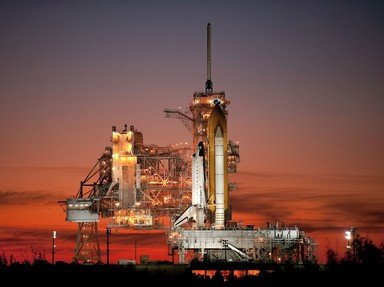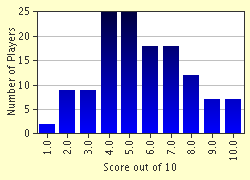Quiz Answer Key and Fun Facts
1. The maiden launch of Space Shuttle Discovery on mission STS-41D was originally delayed over a month in order to replace a malfunctioning main engine. When finally back on the launch pad, the launch was delayed another six minutes and 50 seconds for what reason?
2. The launch of Shuttle mission STS-36 was delayed for four days due to an illness of the crew's commander. This was the first time since Apollo 13 that a launch was affected by a crewmember's illness. Who was the commander for STS-36?
3. The launch of Shuttle mission STS-44 was first delayed for five days due to equipment malfunctions, but while set to go the second time, it had to be delayed another 13 minutes in part for what reason?
4. A Pad Abort is a very risky scenario, in which a launch attempt has to be scrubbed after the main engines have already been ignited, but prior to igniting the Solid Rocket Boosters. How close to launch was Shuttle mission STS-68 when the Shuttle's General Purpose Computers initiated the launch abort sequence due to a main engine turbopump failure?
5. The Space Shuttle launch pads in Cape Canaveral, Florida are vulnerable to hurricane and tropical storm threats due to location. If a Shuttle is sitting on the launch pad when a hurricane threat develops, the Shuttle is rolled back to the Vehicle Assembly Building for protection. One instance of a Shuttle delay due to a hurricane was the 1996 mission STS-79. What was unusual about this delay?
6. In 2006, Hurricane Ernesto continued to develop while a Shuttle was sitting on the launch pad. As with other hurricane threats, NASA decided to roll the Shuttle back to the Vehicle Assembly Building for protection. While the Shuttle was in transit, the weather situation changed and the Shuttle turned around and headed back. This was the first time a rollback was cancelled while the Shuttle was in transit. Which Shuttle flight was this?
7. A little over two minutes into a Shuttle launch, the Solid Rocket Boosters are depleted of fuel and are jettisoned, and parachute down into the water. When an 800 foot long ship entered the restricted waters where the SRBs were set to land, Shuttle Mission STS-61 had to be delayed by 24 hours. A similar occurence delayed STS-51D by 55 mintues, and STS-51I by three minutes. Which body of water do the SRBs land in?
8. The launch of Shuttle Mission STS-115 was delayed by 24 hours in order to assess any potential damage incurred when the launch pad was struck by the largest lightning strike ever recorded at the Kennedy Space Center, in August 2006. Which orbiter was on the pad when this occurred?
9. Hurricanes and lightning are not the only causes of Shuttle damage while sitting at the pad. What weather phenomenon caused damage to the External Tank and caused Shuttle mission STS-96 to be rolled back to the Vehicle Assembly Building for repairs?
10. Now for the most bizarre incident causing a Shuttle launch to be delayed. While sitting on the launch pad, the External Tank for STS-70 was damaged with 71 holes ranging in size from four inches to a half inch. What caused these holes?
Source: Author
mcdubb
This quiz was reviewed by FunTrivia editor
bloomsby before going online.
Any errors found in FunTrivia content are routinely corrected through our feedback system.

